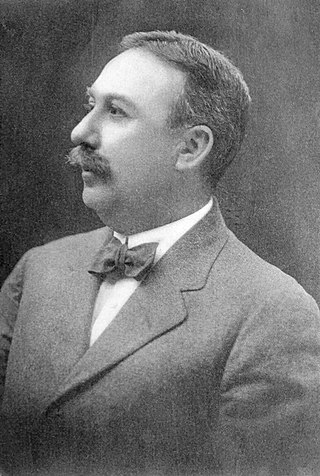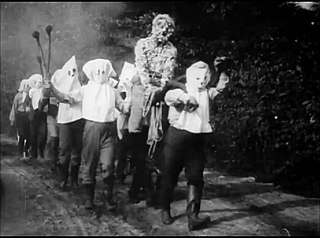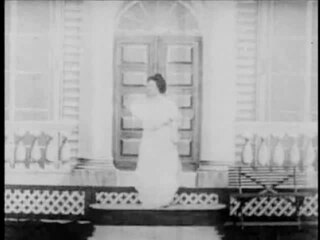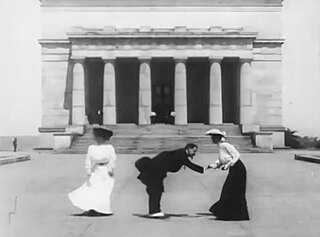Related Research Articles
The year 1903 in film involved many significant events in cinema.
The year 1901 in film involved some significant events.

Edwin Stanton Porter was an American film pioneer, most famous as a producer, director, studio manager and cinematographer with the Edison Manufacturing Company and the Famous Players Film Company. Of over 250 films created by Porter, his most important include What Happened on Twenty-third Street, New York City (1901), Jack and the Beanstalk (1902), Life of an American Fireman (1903), The Great Train Robbery (1903), The European Rest Cure (1904), The Kleptomaniac (1905), Life of a Cowboy (1906), Rescued from an Eagle's Nest (1908), and The Prisoner of Zenda (1913).

Edison Studios was an American film production organization, owned by companies controlled by inventor and entrepreneur, Thomas Edison. The studio made close to 1,200 films, as part of the Edison Manufacturing Company (1894–1911) and then Thomas A. Edison, Inc. (1911–1918), until the studio's closing in 1918. Of that number, 54 were feature length, and the remainder were shorts. All of the company's films have fallen into the public domain because they were released before 1928.

Life of an American Fireman is a short, silent film Edwin S. Porter made for the Edison Manufacturing Company. It was shot late in 1902 and distributed early in 1903. One of the earliest American narrative films, it depicts the rescue of a woman and child from a burning building. It bears notable similarities to the 1901 British short film Fire!, directed by James Williamson.

Another Job for the Undertaker is a 1901 silent comic trick film made at Edison's recently opened studio at 41 East 21st Street in Manhattan. It was photographed by Edwin S. Porter and co-directed by Porter and George S. Fleming. The two-shot film was copyrighted on May 15, 1901 and is approximately two minutes in length. It lacks a head title, which would have been supplied by projecting a separate lantern slide before screening the film.

The Kiss in the Tunnel, also known as A Kiss in the Tunnel, is a 1899 British short silent, comedy film, produced and directed by George Albert Smith, showing a couple sharing a brief kiss as their train passes through a tunnel, which is said to mark the beginnings of narrative editing. The film is the first to feature Laura Bayley, Smith's wife.

What Happened on Twenty-third Street, New York City is a 1901 American short film starring A. C. Abadie and Florence Georgie in which a woman's undergarments are accidentally exposed. A similar 1901 film, Soubrette's Troubles on a Fifth Avenue Stage, also starred Abadie and Georgie.
Wallace McCutcheon Sr. was a pioneer cinematographer and director in the early American motion picture industry, working with the American Mutoscope & Biograph, Edison and American Star Film companies. McCutcheon's wealth of credits are often mixed up with the small handful of films directed by his son, Wallace McCutcheon Jr. (1884–1928).
The Treasures from American Film Archives series of DVDs is produced by the National Film Preservation Foundation (NFPF), a nonprofit organization created by the U.S. Congress in 1997. The NFPF publishes these DVD sets, with accompanying booklets and extensive commentary, to promote public access to the films preserved by the American archival community.
George S. Fleming was an American actor, director, and scenic designer whose short films were influential early projects in the medium.

Kansas Saloon Smashers is a 1901 comedy short film produced and distributed by Edison Studios. Directed by Edwin S. Porter, it is a satire of American activist Carrie Nation. The film portrays Nation and her followers entering and destroying a saloon. After the bartender retaliates by spraying Nation with water, policemen order them out; the identities of the actors are not known. Inspiration for the film was provided by an editorial cartoon which appeared in the New York Evening Journal.

"Weary Willie" Kisses the Bride is a surviving 1904 silent comedy short film produced by Thomas Edison and directed by Edwin S. Porter and preserved from a paper print in the Library of Congress. The film was copyrighted as Nervy Nat Kisses the Bride, but sold as "Weary Willie". Another 1904 Porter short was released called "Weary Willie" Kidnaps a Child.
Gilbert Saroni, also written Gilbert Sarony, was a cross-dressing actor in vaudeville as well as early Edison Manufacturing, American Mutoscope, and Siegmund Lubin films. In his obituary in Variety he was described as one of the first impersonators of the "old maid" type and was said to be "considered one of the funniest men in the show business."

Meet Me at the Fountain is a 1904 American silent short comedy film written, produced, and directed by Siegmund Lubin. Actors in the movie included Gilbert Sarony, a well-known cross-dressing performer. The film was inspired by Wallace McCutcheon's 1904 film Personal.

Uncle Josh at the Moving Picture Show is a 1902 American short silent comedy film directed by Edwin S. Porter, featuring a naive spectator trying to interact with films projected onto a screen. It is an almost identical remake of a British 1901 film directed by Robert W. Paul, The Countryman and the Cinematograph. Paul's film was the first to feature a film shown within a film.

The White Caps is a 1905 American silent drama film, directed by Wallace McCutcheon and Edwin S. Porter showing how a man abusing his wife is punished by a group of white-hooded men. It is one of the first American films exposing conjugal violence against women and showing the action of vigilante groups.

The Seven Ages is a 1905 American silent comedy film, directed by Edwin S. Porter inspired by the monologue All the World's a Stage in William Shakespeare's comedy As You Like It.

The Gay Shoe Clerk is a 1903 silent short film directed by Edwin S. Porter. The film depicts a risqué comic encounter between a clerk and his female customer while she is trying on shoes.

How a French Nobleman Got a Wife Through the New York Herald Personal Columns is a 1904 silent comic film directed by Edwin S. Porter for the Edison Manufacturing Company. The film is a remake of the hit film Personal, produced by the Biograph Company earlier in the year. The film is a spoof of the "fashionable marriages" known to take place between cash-strapped European nobility and American heiresses.
References
- ↑ Porter, Edwin; Anderson, Gilbert (1903). "What happened in the tunnel". Library of Congress .
- ↑ "What Happened in the Tunnel". American Film Institute Catalog. ProQuest 1746546976.
- ↑ "What Happened in the Tunnel (1903)". Century Film Project. Archived from the original on March 7, 2017.
{{cite web}}: CS1 maint: unfit URL (link) - ↑ Rabinovitz, Lauren (1988). For the Love of Pleasure Women, Movies, and Culture in Turn-of-the-century Chicago. Rutgers University Press. ISBN 0813525349.